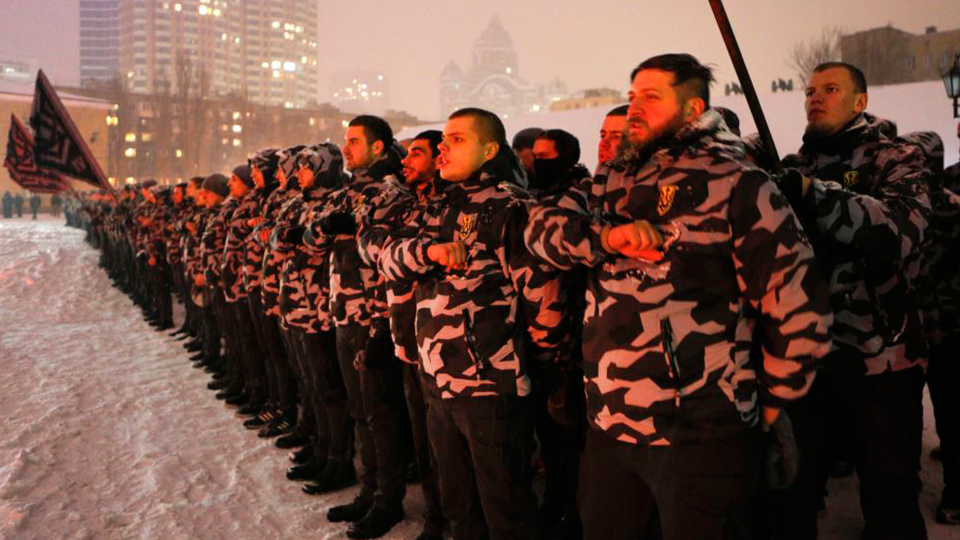
Volunteers of the right-wing paramilitary Azov Civil Corps swear an oath of allegiance in central Kyiv on January 28 | Efrem Lukatsky, AP
In an attempt to thwart pro-worker demonstrations planned for May Day in Ukraine, government “security services” broke into Communist Party buildings in that country yesterday, according to press releases sent out of the country by the party. The party statement said the government security forces acted on information provided by Svoboda (Freedom).
Svoboda, which is connected to the Social Nationalist Party of the Ukraine, a well-known pro-Nazi party, claimed the communists were harboring illegal activities including passing out post cards in celebration of the May 9, 1945 allied victory over fascism and planning illegal pro-worker demonstrations on May Day next week. While those activities have indeed been declared illegal by the Ukrainian government the use of fascist symbols and flags, fascist marches and the construction of memorials honoring Nazis are all entirely legal now in that country.
The current government in Kiev came to power in a coup that ousted Viktor Yanukovych, the democratically elected president of the country and then slaughtered thousands of ethnic Russians who resisted the new fascist government.
According to the communists, the government has declared as illegal leaflets seized yesterday that read: “Long live May 1 – the day of solidarity with working people.” Incredibly, Ukraine is now one of the very few countries where the celebration of May Day has been banned. It is currently celebrated in at least 142 countries, the Ukrainian Communist Party notes in its statement on yesterday’s raid.
Other leaflets seized read, “We demand Peace, Jobs, and Salaries!” The government said the leaflets were seized because they endanger the “sovereignty” of the Ukraine. “These guardians of the regime apparently confused the interests of the state with the interests of the oligarchs,” the communist statement read.
The party has appealed to the United Nations Human Rights Council for action against the government’s violation of its rights.
The Kiev government has a long and dubious record in the area of human rights, a record ignored by much of the U.S. media which portrays the Ukrainian government as a bastion of freedom fighting against Russian “invaders.”
Celebrations of anniversaries of progressive victories have always been a sore spot for the Ukrainian fascists. When the 70th anniversary of the end of the Holocaust was celebrated three years ago, for example, the parliament in Kiev extended official recognition to political groupings that had collaborated with the Nazis in murdering Jews. Among those recognized as legal groups was the Ukrainian Insurgent Army, an ultra right, anti-Semitic group that had openly worked with the Nazis.
In the time span of only a few months in 2015 there were at least ten mysterious deaths of opposition figures with the government claiming they were all suicides. One of those killed was Oleg Kalishnikov, a leader of the opposition Party of Regions, who was shot in his own home after he had been campaigning for the right of Ukrainians to celebrate the allied victory in World War II.
His death and the killing of numerous opposition journalists have been largely ignored in the western media.
Those included the murder of Ukrainian journalist Oles Buzna, a critic of the Kiev fascists, who had protested censorship that the Ukraine has imposed on news outlets that don’t carry forward the government’s positon on issues. Also murdered was the dissident journalist Seriy Sukhobok. There were reports after his death that his assailants had been found but later the government changed its story and said they had not been found.
The U.S. State Department, both during the Obama years and now under Trump, has pushed the narrative that the Ukrainian government has been initiating democratic reforms. While there is little evidence of any such reforms the government has been busy, however, slashing pensions for seniors, hiking fuel prices and implementing International Monetary Fund demands for austerity in exchange for that fund having bailed out Ukrainian banks.
Nazism has a long history in Western Ukraine since World War II, particularly in cities such as Lviv which boasts a well-kept cemetery to veterans of the Galician SS, the Ukrainian chapter of the Nazi SS.
The “mass” protests against the last legally elected president, Yanukovych, included 100-member brigades of neo-Nazi militias bused into Kiev. After the coup, Anriy Parubiy, a leader in Svoboda who was a fascist commander of the so-called “defense forces” of the demonstrators in Kiev, was elevated to the post of national security director. He led the government expeditions into eastern Ukraine to fight the ethnic Russians resisting the coup. Thousands of the pro-fascist fighters marched into ethnic Russian villages in eastern Ukraine under banners bearing swastikas and other fascist symbols.
The generally right-wing London Telegraph departed from the type of reporting at that time generally seen in the U.S. when its correspondent, Tom Partiff, wrote in an article: “Kiev’s use of voluntary paramilitaries to stamp out Russian-backed Donetsk and Luhansk ‘peoples republics’ should send a shiver down Europe’s spine…the men use the neo-Nazi Wolfsangel (Wolf’s Hook) symbol on their banner and members of the battalion are openly white supremacists, or anti-Semites.
In interviews with the Telegraph, fighters denied the Holocaust, expressed admiration for Adolf Hitler and said that they were in fact Nazis.

No comments:
Post a Comment